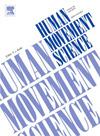非沉浸式VR的准确性和稳定性:显示类型和身体位置如何影响运动性能
IF 1.9
3区 心理学
Q4 NEUROSCIENCES
引用次数: 0
摘要
虚拟现实和增强现实的应用横跨各个领域,包括教育、娱乐、医疗、军事、体育、电信和太空探索。这些技术进步深刻地改变了数百万人与环境互动和导航的方式。然而,显示类型和身体位置对运动性能的影响仍未得到充分探讨。本研究旨在通过比较虚拟现实(VR)护目镜和投影屏幕两种显示条件下的表现,阐明这些环境约束如何影响双手协调。参与者(N = 12),均为右肢优势,使用Lissajous图作为视觉反馈,在相对相位偏移90°的情况下进行连续1:1的双手力协调任务。在两个身体位置(直立和平躺)由倾斜桌操纵的性能进行评估。结果显示,使用VR护目镜可以最大限度地减少直立和平卧姿势之间的表现差异,这表明使用VR护目镜可以通过减少感知干扰和减轻环境约束来稳定运动协调。相比之下,投影屏幕条件下,平躺状态下8-12 Hz频段的力相干性高于直立状态,表明力同步差异与身体位置有关。然而,投影屏幕组在平卧位置时显示出较低的绝对误差。这表明,虽然VR护目镜通过简化感知输入来支持不同姿势的一致运动输出,但投影屏幕可以通过更直接的视觉处理来增强受控条件下的运动同步和注意力。这些发现强调了显示类型之间的权衡:VR提供稳定性和适应性,使其有利于需要在不同姿势下保持一致表现的任务,而投影屏幕可能更适合需要精确运动控制和高度注意力集中的任务。该研究强调了在设计和使用训练、康复和运动协调任务的显示环境时需要考虑具体任务。本文章由计算机程序翻译,如有差异,请以英文原文为准。
Accuracy and stability in non-immersive VR: How display type and body position influence motor performance
The application of virtual and augmented reality spans various domains, including education, entertainment, healthcare, the military, sports, telecommunications, and space exploration. These technological advancements have profoundly transformed how millions of people interact with and navigate their environments. However, the impact of display type and body position on motor performance remains underexplored. This study aims to elucidate how these environmental constraints affect bimanual coordination by comparing performance under two display conditions: virtual reality (VR) goggles and projected screen. Participants (N = 12), all right-limb dominant, performed a continuous 1:1 bimanual force coordination task with a 90° relative phase offset using Lissajous plots as visual feedback. Performance was assessed in two body positions (upright and recumbent) manipulated by a tilt table. The results revealed that using VR goggles minimized performance differences between the upright and recumbent positions, suggesting that using VR goggles stabilizes motor coordination by reducing perceptual distractions and mitigating environmental constraints. In contrast, the projection screen condition demonstrated higher force coherence in the 8–12 Hz band during the recumbent condition compared to the upright position, indicative of force synchronization differences related to body position. However, the projected screen group displayed lower absolute error during the recumbent positions. This suggests that while VR goggles support consistent motor output across varied postures by simplifying perceptual input, projection screens may enhance motor synchronization and attention under controlled conditions due to more straightforward visual processing. These findings highlight a trade-off between display types: VR offers stability and adaptability, making it advantageous for tasks that require consistent performance across changing postures, whereas projection screens may be better suited for tasks requiring precise motor control and heightened attentional focus. The study underscores the need for task-specific considerations in the design and use of display environments for training, rehabilitation, and motor coordination tasks.
求助全文
通过发布文献求助,成功后即可免费获取论文全文。
去求助
来源期刊

Human Movement Science
医学-神经科学
CiteScore
3.80
自引率
4.80%
发文量
89
审稿时长
42 days
期刊介绍:
Human Movement Science provides a medium for publishing disciplinary and multidisciplinary studies on human movement. It brings together psychological, biomechanical and neurophysiological research on the control, organization and learning of human movement, including the perceptual support of movement. The overarching goal of the journal is to publish articles that help advance theoretical understanding of the control and organization of human movement, as well as changes therein as a function of development, learning and rehabilitation. The nature of the research reported may vary from fundamental theoretical or empirical studies to more applied studies in the fields of, for example, sport, dance and rehabilitation with the proviso that all studies have a distinct theoretical bearing. Also, reviews and meta-studies advancing the understanding of human movement are welcome.
These aims and scope imply that purely descriptive studies are not acceptable, while methodological articles are only acceptable if the methodology in question opens up new vistas in understanding the control and organization of human movement. The same holds for articles on exercise physiology, which in general are not supported, unless they speak to the control and organization of human movement. In general, it is required that the theoretical message of articles published in Human Movement Science is, to a certain extent, innovative and not dismissible as just "more of the same."
 求助内容:
求助内容: 应助结果提醒方式:
应助结果提醒方式:


